Semantic Segmentation of Transmission Corridor 3D Point Clouds Based on CA-PointNet++
Abstract
:1. Introduction
- Proposing a novel end-to-end CA-PointNet++ network for semantic segmentation. To improve segmentation accuracy, a Coordinate Attention module is embedded to integrate channel relationships and feature space position information, suppressing unimportant information in the 3D point clouds.
- Applying the proposed improved deep learning network to the actual collected transmission corridor data set for semantic segmentation, accurately dividing the transmission corridor into transmission lines, towers, ground wires, and ground, effectively demonstrating the feasibility and effectiveness of the model.
- Conducting a comprehensive comparative analysis of the segmentation effect of different attention modules embedded in the backbone network in transmission corridor semantic segmentation, verifying the superiority of the proposed model.
2. Methodology
2.1. CA-PointNet++ Framework
2.2. Coordinate Attention
2.3. Proposed CA-PointNet++ Model
3. Experiments and Results
3.1. Data Descriptions
3.2. Experimental Setting
3.3. Evaluation Metrics
3.4. Results Analysis
4. Discussion
5. Conclusions
Author Contributions
Funding
Data Availability Statement
Conflicts of Interest
References
- Yang, L.; Fan, J.; Liu, Y.; Li, E.; Peng, J.; Liang, Z. A Review on State-of-the-Art Power Line Inspection Techniques. IEEE Trans. Instrum. Meas. 2020, 69, 9350–9365. [Google Scholar] [CrossRef]
- Peng, X.; Chen, C.; Rao, Z.; Yang, B.; Mai, X.; Wang, K. Safety Inspection and Intelligent Diagnosis of Transmission Line Based on Unmanned Helicopter of Multi Sensor Data Acquisition. High Volt. Eng. 2015, 41, 159–166. [Google Scholar] [CrossRef]
- Daki, H.; El Hannani, A.; Aqqal, A.; Haidine, A.; Dahbi, A. Big Data Management in Smart Grid: Concepts, Requirements and Implementation. J. Big Data 2017, 4, 13. [Google Scholar] [CrossRef] [Green Version]
- Qarabsh, N.A.; Sabry, S.S.; Qarabash, H.A. Smart Grid in the Context of Industry 4.0: An Overview of Communications Technologies and Challenges. Indones. J. Electr. Eng. Comput. Sci. 2020, 18, 656–665. [Google Scholar] [CrossRef] [Green Version]
- Wen, Q.; Luo, Z.; Chen, R.; Yang, Y.; Li, G. Deep Learning Approaches on Defect Detection in High Resolution Aerial Images of Insulators. Sensors 2021, 21, 1033. [Google Scholar] [CrossRef]
- Popișter, F.; Popescu, D.; Păcurar, A.; Păcurar, R. Mathematical Approach in Complex Surfaces Toolpaths. Mathematics 2021, 9, 1360. [Google Scholar] [CrossRef]
- Brede, B.; Lau, A.; Bartholomeus, H.M.; Kooistra, L. Comparing RIEGL RiCOPTER UAV LiDAR Derived Canopy Height and DBH with Terrestrial LiDAR. Sensors 2017, 17, 2371. [Google Scholar] [CrossRef] [Green Version]
- Jaakkola, A.; Hyyppä, J.; Yu, X.; Kukko, A.; Kaartinen, H.; Liang, X.; Hyyppä, H.; Wang, Y. Autonomous Collection of Forest Field Reference—The Outlook and a First Step with UAV Laser Scanning. Remote Sens. 2017, 9, 785. [Google Scholar] [CrossRef] [Green Version]
- Chen, C.; Yang, B.; Song, S.; Peng, X.; Huang, R. Automatic Clearance Anomaly Detection for Transmission Line Corridors Utilizing UAV-Borne LIDAR Data. Remote Sens. 2018, 10, 613. [Google Scholar] [CrossRef] [Green Version]
- Cong, Y.; Chen, C.; Yang, B.; Li, J.; Wu, W.; Li, Y.; Yang, Y. 3D-CSTM: A 3D Continuous Spatio-Temporal Mapping Method. ISPRS J. Photogramm. Remote Sens. 2022, 186, 232–245. [Google Scholar] [CrossRef]
- Boukoberine, M.N.; Zhou, Z.; Benbouzid, M. A Critical Review on Unmanned Aerial Vehicles Power Supply and Energy Management: Solutions, Strategies, and Prospects. Appl. Energy 2019, 255, 113823. [Google Scholar] [CrossRef]
- Jiang, Z.; Lv, H.; Li, Y.; Guo, Y. A Novel Application Architecture of Digital Twin in Smart Grid. J. Ambient. Intell. Humaniz. Comput. 2022, 13, 3819–3835. [Google Scholar] [CrossRef]
- Chi, P.; Lei, Y.; Shan, S.S.; Wei, Z.; Hao, D. Research on Power Line Segmentation and Tree Barrier Analysis. In Proceedings of the 2019 3rd International Conference on Electronic Information Technology and Computer Engineering, Xiamen, China, 18–20 October 2019; pp. 1395–1399. [Google Scholar]
- Hu, Z.; He, T.; Zeng, Y.; Luo, X.; Wang, J.; Huang, S.; Liang, J.; Sun, Q.; Xu, H.; Lin, B. Fast Image Recognition of Transmission Tower Based on Big Data. Prot. Control. Mod. Power Syst. 2018, 3, 15. [Google Scholar] [CrossRef]
- Gao, J.; Wang, L.; Wu, S.; Xie, C.; Liu, L.; Li, E.; Wang, T.; Cavallini, A. Breakdown Characteristics of a Long Air Gap Containing a Floating Conductor Under Positive Switching Impulse. IEEE Trans. Dielectr. Electr. Insul. 2022, 29, 1913–1922. [Google Scholar] [CrossRef]
- Xie, C.; Wang, L.; Gao, J.; Peng, Y.; Wu, S.; Wu, S.; Wang, W.; Liu, J.; Liu, Y. Experimental Investigation of Discharge Path Selectivity of a Long Air Gap Containing a Floating Conductor. IEEE Trans. Electromagn. Compat. 2022, 64, 1278–1287. [Google Scholar] [CrossRef]
- Guo, B.; Li, Q.; Huang, X.; Wang, C. An Improved Method for Power-Line Reconstruction from Point Cloud Data. Remote Sens. 2016, 8, 36. [Google Scholar] [CrossRef] [Green Version]
- Knapp, N.; Fischer, R.; Huth, A. Linking Lidar and Forest Modeling to Assess Biomass Estimation across Scales and Disturbance States. Remote Sens. Environ. 2018, 205, 199–209. [Google Scholar] [CrossRef]
- Kohek, Š.; Žalik, B.; Strnad, D.; Kolmanič, S.; Lukač, N. Simulation-Driven 3D Forest Growth Forecasting Based on Airborne Topographic LiDAR Data and Shading. Int. J. Appl. Earth Obs. Geoinf. 2022, 111, 1–13. [Google Scholar] [CrossRef]
- Tompalski, P.; Coops, N.C.; White, J.C.; Goodbody, T.R.; Hennigar, C.R.; Wulder, M.A.; Socha, J.; Woods, M.E. Estimating Changes in Forest Attributes and Enhancing Growth Projections: A Review of Existing Approaches and Future Directions Using Airborne 3D Point Cloud Data. Curr. For. Rep. 2021, 7, 1–24. [Google Scholar] [CrossRef]
- Jwa, Y.; Sohn, G.; Kim, H.B. Automatic 3d Powerline Reconstruction Using Airborne Lidar Data. Int. Arch. Photogramm. Remote Sens. 2009, 38, 105–110. [Google Scholar]
- Zhang, R.; Yang, B.; Xiao, W.; Liang, F.; Liu, Y.; Wang, Z. Automatic Extraction of High-Voltage Power Transmission Objects from UAV Lidar Point Clouds. Remote Sens. 2019, 11, 2600. [Google Scholar] [CrossRef] [Green Version]
- Chen, S.; Wang, C.; Dai, H.; Zhang, H.; Pan, F.; Xi, X.; Yan, Y.; Wang, P.; Yang, X.; Zhu, X. Power Pylon Reconstruction Based on Abstract Template Structures Using Airborne Lidar Data. Remote Sens. 2019, 11, 1579. [Google Scholar] [CrossRef] [Green Version]
- Guo, B.; Huang, X.; Zhang, F.; Sohn, G. Classification of Airborne Laser Scanning Data Using JointBoost. ISPRS J. Photogramm. Remote Sens. 2015, 100, 71–83. [Google Scholar] [CrossRef]
- Toschi, I.; Morabito, D.; Grilli, E.; Remondino, F.; Carlevaro, C.; Cappellotto, A.; Tamagni, G.; Maffeis, M. CLOUD-BASED SOLUTION FOR NATIONWIDE POWER LINE MAPPING. Int. Arch. Photogramm. Remote Sens. Spat. Inf. Sci. 2019, XLII-2/W13, 119–126. [Google Scholar] [CrossRef] [Green Version]
- Chen, C.; Jin, A.; Yang, B.; Ma, R.; Sun, S.; Wang, Z.; Zong, Z.; Zhang, F. DCPLD-Net: A Diffusion Coupled Convolution Neural Network for Real-Time Power Transmission Lines Detection from UAV-Borne LiDAR Data. Int. J. Appl. Earth Obs. Geoinf. 2022, 112, 102960. [Google Scholar] [CrossRef]
- Su, H.; Maji, S.; Kalogerakis, E.; Learned-Miller, E. Multi-View Convolutional Neural Networks for 3d Shape Recognition. In Proceedings of the IEEE International Conference on Computer Vision, Santiago, Chile, 7–13 December 2015; pp. 945–953. [Google Scholar]
- Guo, Y.; Wang, H.; Hu, Q.; Liu, H.; Liu, L.; Bennamoun, M. Deep Learning for 3d Point Clouds: A Survey. IEEE Trans. Pattern Anal. Mach. Intell. 2020, 43, 4338–4364. [Google Scholar] [CrossRef]
- Maturana, D.; Scherer, S. Voxnet: A 3d Convolutional Neural Network for Real-Time Object Recognition. In Proceedings of the 2015 IEEE/RSJ International Conference on Intelligent Robots and Systems, Hamburg, Germany, 28 September–2 October 2015; pp. 922–928. [Google Scholar]
- Qi, C.R.; Su, H.; Mo, K.; Guibas, L.J. Pointnet: Deep Learning on Point Sets for 3d Classification and Segmentation. In Proceedings of the IEEE Conference on Computer Vision and Pattern Recognition, Honolulu, HI, USA, 21–26 July 2017; pp. 652–660. [Google Scholar]
- Qi, C.R.; Yi, L.; Su, H.; Guibas, L.J. Pointnet++: Deep Hierarchical Feature Learning on Point Sets in a Metric Space. In Proceedings of the Advances in Neural Information Processing Systems, Long Beach, CA, USA, 4–9 December 2017; pp. 5105–5114. [Google Scholar]
- Li, Y.; Bu, R.; Sun, M.; Wu, W.; Di, X.; Chen, B. Pointcnn: Convolution on x-Transformed Points. In Proceedings of the Advances in Neural Information Processing Systems, Montreal, Canada, 3–8 December 2018; pp. 820–830. [Google Scholar]
- Wang, Y.; Sun, Y.; Liu, Z.; Sarma, S.E.; Bronstein, M.M.; Solomon, J.M. Dynamic Graph Cnn for Learning on Point Clouds. Acm Trans. Graph. 2019, 38, 1–12. [Google Scholar] [CrossRef] [Green Version]
- Zhang, Z.; Hua, B.-S.; Yeung, S.-K. Shellnet: Efficient Point Cloud Convolutional Neural Networks Using Concentric Shells Statistics. In Proceedings of the IEEE/CVF International Conference on Computer Vision, Seoul, Republic of Korea, 27 October–2 November 2019; pp. 1607–1616. [Google Scholar]
- Yang, J.; Huang, Z.; Huang, M.; Zeng, X.; Li, D.; Zhang, Y. Power Line Corridor LiDAR Point Cloud Segmentation Using Convolutional Neural Network. In Proceedings of the Pattern Recognition and Computer Vision: Second Chinese Conference, Xi’an, China, 8–11 November 2019; pp. 160–171. [Google Scholar]
- Peng, S.; Xi, X.; Wang, C.; Xie, R.; Wang, P.; Tan, H. Point-Based Multilevel Domain Adaptation for Point Cloud Segmentation. IEEE Geosci. Remote Sens. Lett. 2020, 19, 1–5. [Google Scholar] [CrossRef]
- Hou, Q.; Zhou, D.; Feng, J. Coordinate Attention for Efficient Mobile Network Design. In Proceedings of the IEEE/CVF Conference on Computer Vision and Pattern Recognition, Nashville, TN, USA, 20–25 June 2021; pp. 13713–13722. [Google Scholar]
- Hu, J.; Shen, L.; Sun, G. Squeeze-and-Excitation Networks. In Proceedings of the IEEE Conference on Computer Vision and Pattern Recognition, Salt Lake City, UT, USA, 18–23 June 2018; pp. 7132–7141. [Google Scholar]
- Woo, S.; Park, J.; Lee, J.-Y.; Kweon, I.S. Cbam: Convolutional Block Attention Module. In Proceedings of the European Conference on Computer Vision (ECCV), Munich, Germany, 8–14 September 2018; pp. 3–19. [Google Scholar]
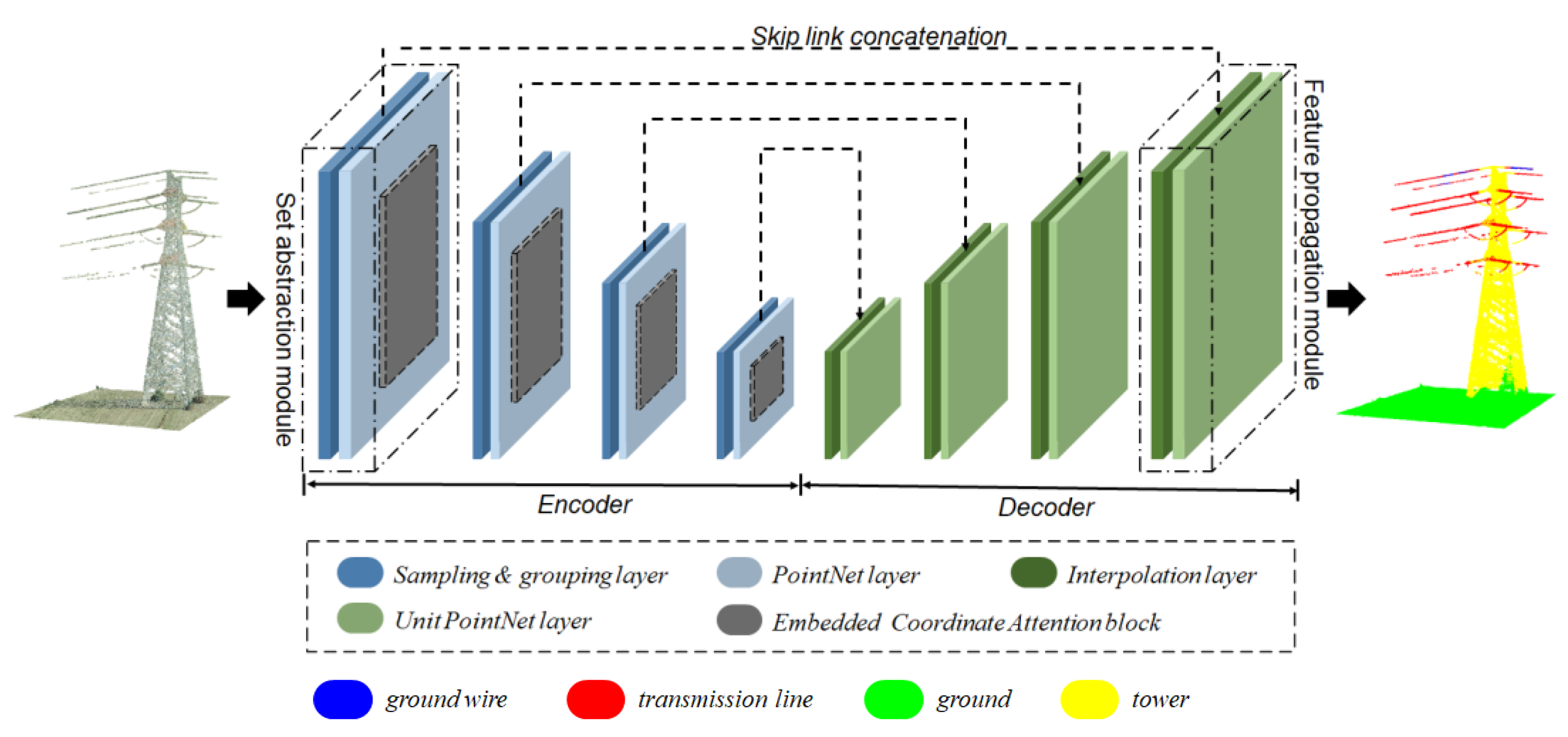
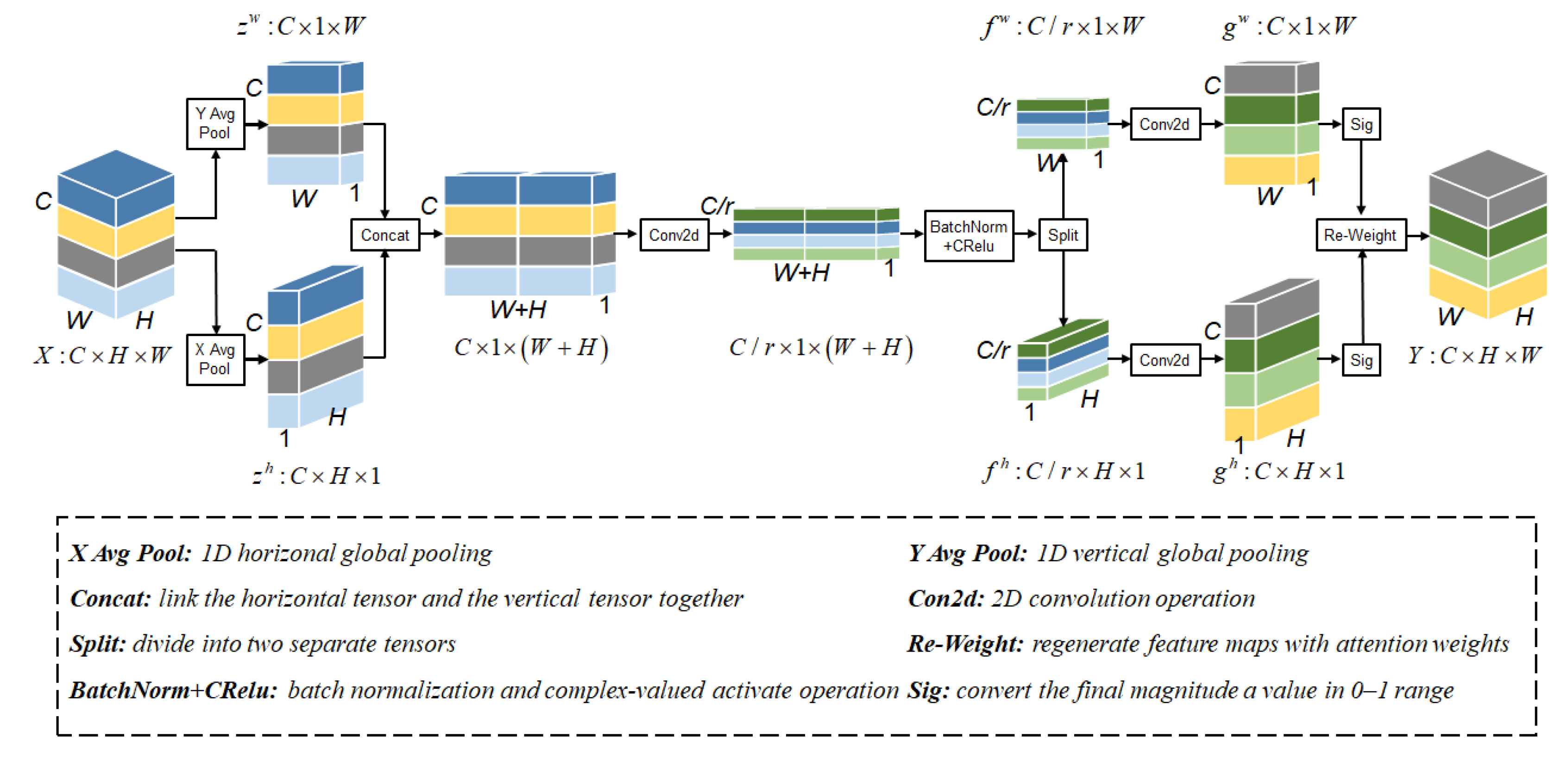
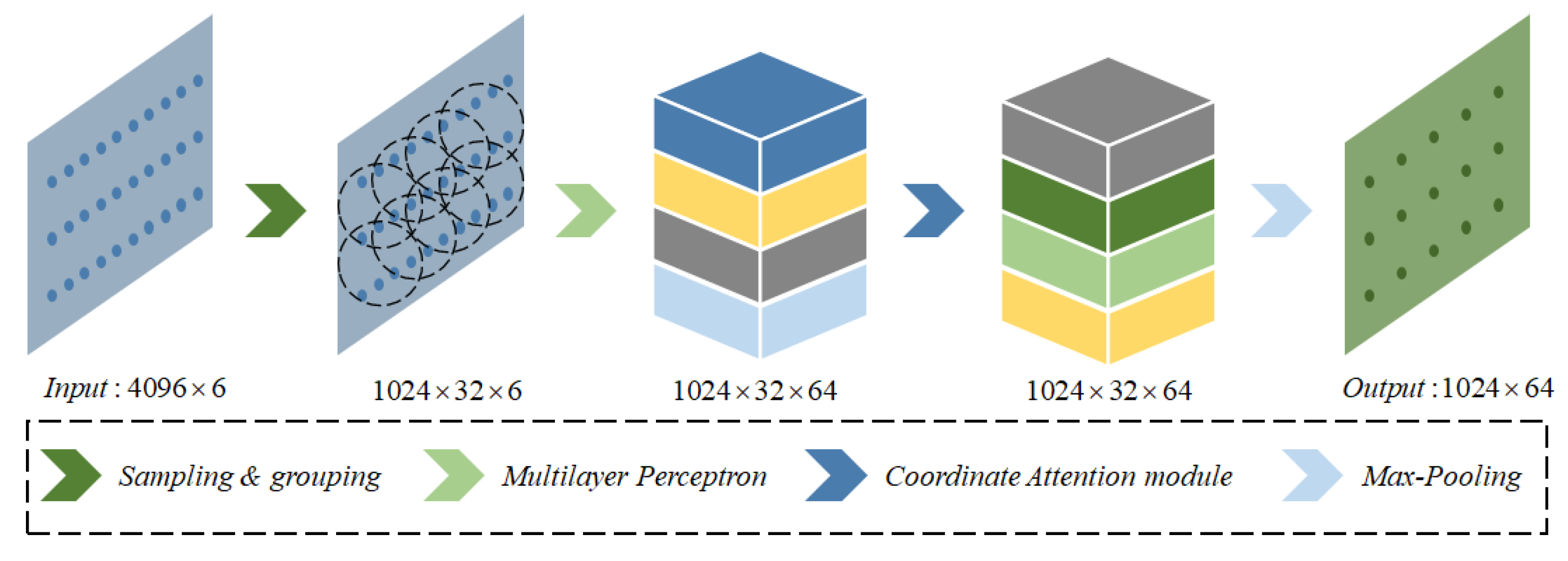
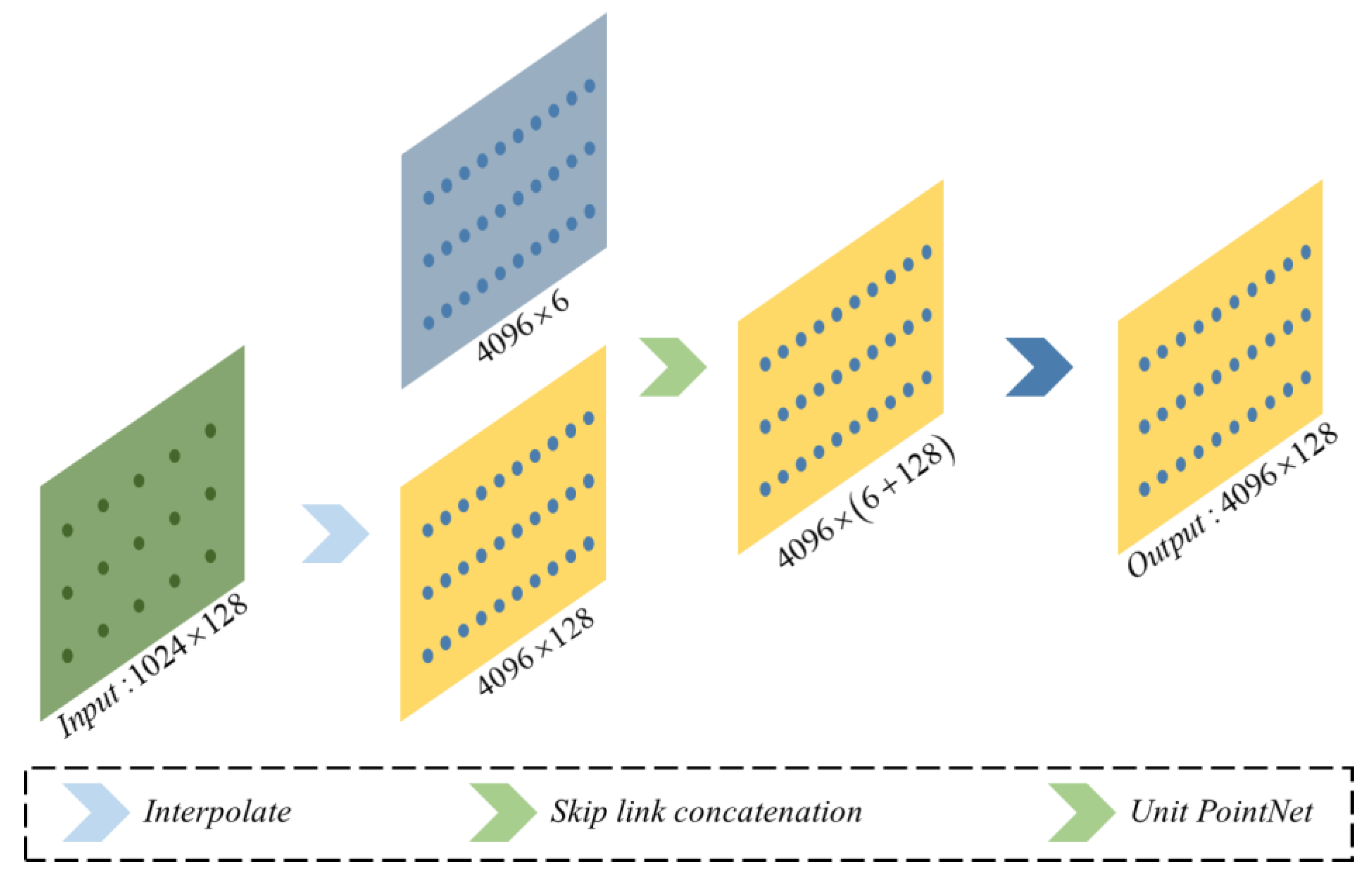


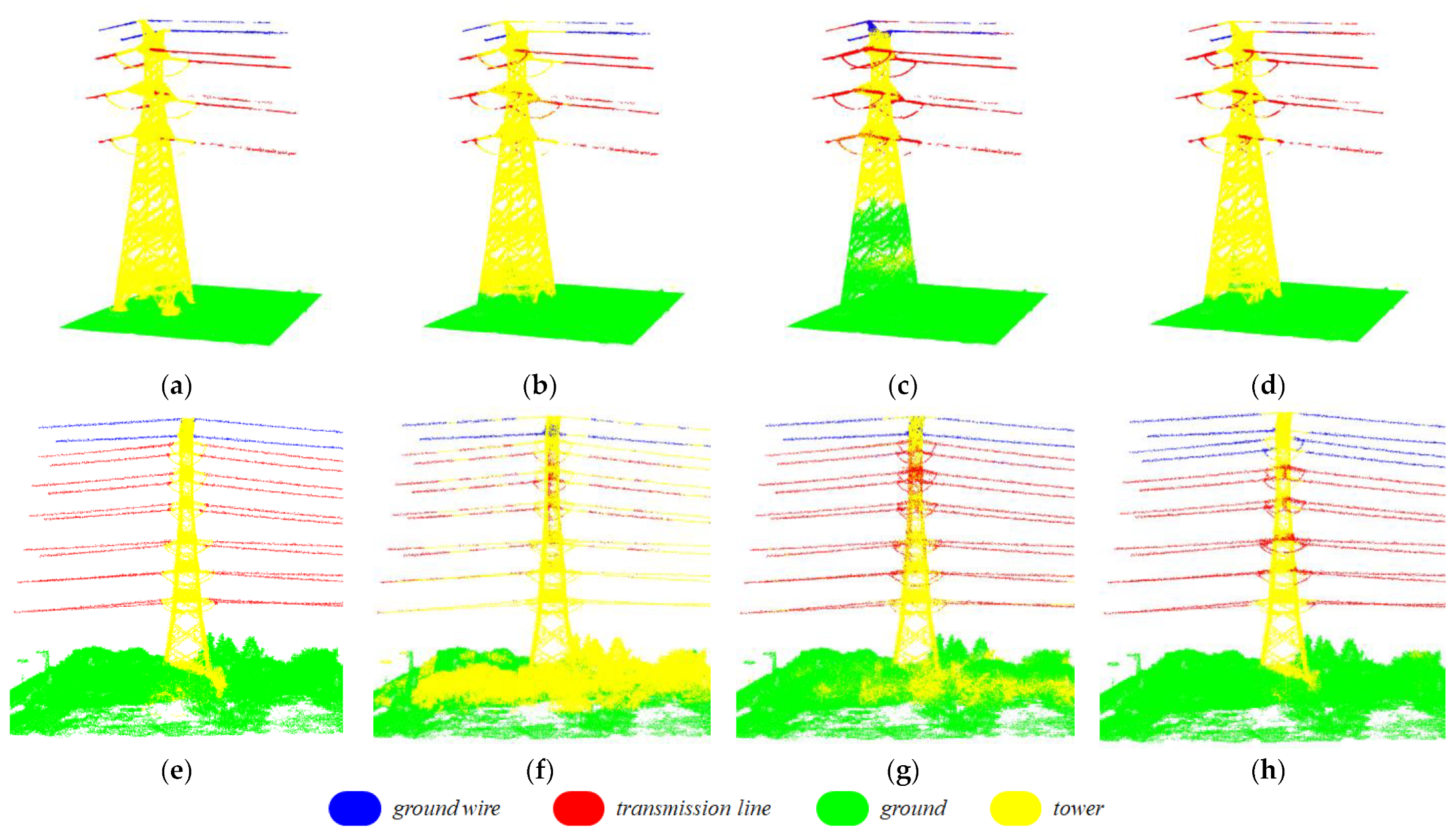
| Categories | Ground Wire # | Ground # | Tower # | Transmission Line # | OA (%) |
|---|---|---|---|---|---|
| ground wire * | 1363 | 0 | 110 | 0 | 92.5 |
| Ground * | 0 | 387,659 | 141 | 0 | 99.9 |
| Tower * | 173 | 11,212 | 50,154 | 2035 | 78.9 |
| transmission line * | 1413 | 0 | 2658 | 8005 | 66.3 |
| Model | OA (%) | IoU (%) | mIoU (%) | |||
|---|---|---|---|---|---|---|
| Tower | Transmission Line | Ground Wire | Ground | |||
| PointNet | 73.9 | 54.9 | 32.0 | 35.6 | 64.3 | 46.7 |
| PointNet++ | 80.3 | 52.8 | 46.6 | 26.6 | 78.3 | 51.1 |
| CA-PointNet++ | 93.7 | 82.9 | 60.4 | 32.8 | 93.5 | 67.4 |
| Model | OA (%) | IoU (%) | mIoU (%) | |||
|---|---|---|---|---|---|---|
| Tower | Transmission Line | Ground Wire | Ground | |||
| PointNet++ | 80.3 | 52.8 | 46.6 | 26.6 | 78.3 | 51.1 |
| SE-PointNet++ | 87.9 | 74.4 | 37.3 | 23.6 | 85.9 | 55.3 |
| CA-PointNet++ | 93.7 | 82.9 | 60.4 | 32.8 | 93.5 | 67.4 |
Disclaimer/Publisher’s Note: The statements, opinions and data contained in all publications are solely those of the individual author(s) and contributor(s) and not of MDPI and/or the editor(s). MDPI and/or the editor(s) disclaim responsibility for any injury to people or property resulting from any ideas, methods, instructions or products referred to in the content. |
© 2023 by the authors. Licensee MDPI, Basel, Switzerland. This article is an open access article distributed under the terms and conditions of the Creative Commons Attribution (CC BY) license (https://creativecommons.org/licenses/by/4.0/).
Share and Cite
Wang, G.; Wang, L.; Wu, S.; Zu, S.; Song, B. Semantic Segmentation of Transmission Corridor 3D Point Clouds Based on CA-PointNet++. Electronics 2023, 12, 2829. https://doi.org/10.3390/electronics12132829
Wang G, Wang L, Wu S, Zu S, Song B. Semantic Segmentation of Transmission Corridor 3D Point Clouds Based on CA-PointNet++. Electronics. 2023; 12(13):2829. https://doi.org/10.3390/electronics12132829
Chicago/Turabian StyleWang, Guanjian, Linong Wang, Shaocheng Wu, Shengxuan Zu, and Bin Song. 2023. "Semantic Segmentation of Transmission Corridor 3D Point Clouds Based on CA-PointNet++" Electronics 12, no. 13: 2829. https://doi.org/10.3390/electronics12132829
APA StyleWang, G., Wang, L., Wu, S., Zu, S., & Song, B. (2023). Semantic Segmentation of Transmission Corridor 3D Point Clouds Based on CA-PointNet++. Electronics, 12(13), 2829. https://doi.org/10.3390/electronics12132829






